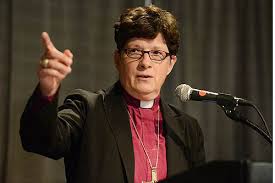When the Rev. Elizabeth Eaton was elected as the Evangelical
Church in America’s first female presiding bishop, it made news. After all,
women have only been ordained in the Lutheran church since 1970. So it only
took forty-three years for the glass ceiling to crack.
(And as any Lutheran readers will tell me, that’s not even accurate since the
ELCA has only been around for twenty-five years. But still…)
 |
| The Rev. Elizabeth Eaton |
Anyway, amidst all the news and interviews, an acquaintance shared his opinion with me that though Martin Luther might have been surprised, Luther's wife, the ex-nun, Katherine Von Bora, might not have been. From what we know of
Katie—and we know a lot because Luther was a prodigious letter writer—she was a
spunky woman who ran the Luther household with a keen head for finances and a
brisk managerial style.
But how did Martin
end up finding Katie? Here’s that story:
In Luther’s personal
letters he long railed against celibacy and spoke of the God-given need for
partnership. And by 1523, he had already booted out the practice of the priest
receiving both bread and wine during Holy Communion while lay people got only
bread.
So he used the same
scripturally-driven logic to condemn a celibate priesthood. What good was it
for a man to be alone? Or a woman, either? If what was good for the priest was
good for the people, then what was good for the people was also good for the priests.
And eventually he
began to play matchmaker with skillful efficiency, drawing from an ample dating
pool, pairing off monks with sisters as more and more of them left their
monasteries and convents. To his friend, George Spalatin, he writes of nine
nuns in particular who had escaped from a Cistercian convent in Saxony in April
1523.
Nine apostate nuns, a wretched group, have
been brought to me by the honest citizens of Torgau…I feel very sorry for them,
but most of all for the many others who are perishing everywhere in their
cursed and impure celibacy.
This sex, which is so very weak by itself and
which is joined by nature, or rather by God, to the other sex, perishes when so
cruelly separated. O tyrants! O cruel parents and kinsmen in Germany! O pope
and bishops, who can curse you as you deserve? Who can sufficiently execrate
the blindness and madness which caused you to teach and enforce such things!
But this is not the place to do it.
You ask me what I shall do with the nuns.
First I shall inform their relatives and ask them to take in the girls. If they
are unwilling, then I shall have the girls provided for elsewhere…They escaped
from the cloister in a miraculous way.
Within a few months,
Luther was successful in finding husbands and dispatching the ex-nuns into new
lives as married women. Finally, only one was left: Katherine von Bora.
Marrying her was a logical next step.
 | |
| Katherine Von Bora |
If logic is what led
him into marriage, it was love that sustained it. Nearly all his personal
letters are peppered with references to ‘my Katie,’--sometimes ‘my lord Katie.’
His greeting in one letter says: “To my dear wife, Catherine Luther, doctor’s
spouse in Wittenberg, keeper of the pig market and gracious wife whom I am
bound to serve hand and foot.”
But when Martin’s
Katie became pregnant speculation ran rampant. What kind of demon could emerge
from the fornication of an ex-nun and an ex-priest, especially an ex-priest
known to be a troublemaker and a rabble-rouser? Catherine would push out a
wreck of a child--a two-headed monster. A spawn of Satan.
Yet when Katie
brought forth the first Luther child, all was intact. Ten fingers, ten toes,
two arms, two legs. Only one head. And as if to re-state the point, Katie and
Martin had five more children, a minivan’s worth of offspring, each of them
equipped with the usual number of appendages.
So there were six
Luther kids at play in the fields of the Lord at precisely the same time that
the church considered marriage between monks and nuns to be both an offense
against doctrine and a mockery of matrimony.
Relationships
evolve, roles change, marriage changes. I like to think the Lutheran Church’s
First Couple would support a female bishop and all the ways that marriage is
evolving. They themselves were, after all, bad-ass rule breakers!
